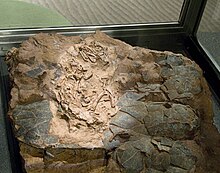Macroelongatoolithus
|
Macroelongatoolithus carlylei Temporal range: Cretaceous |
|
|---|---|
 |
|
| Specimen dubbed "Baby Louie", preserving a Beibeilong hatchling with Macroelongatoolithus eggs | |
| Eggshell classification | |
| Basic shell type: | Ornithoid |
| Morphotype: | Ornithoid-ratite |
| Oofamily: | †Elongatoolithidae |
| Oogenus: | †Macroelongatoolithus |
| Oospecies: | †Macroelongatoolithus carlylei |
| Synonyms | |
|
Oogenus synonymy
|
|
Macroelongatoolithus is an oogenus of large, fossil theropod eggs (probably representing a giant oviraptorid). They are known from Asia and from North America.
Fossil Macroelongatoolithus eggs have been found in the United States, China, and South Korea, ranging in age from Early Cretaceous to Maastrichtian. More specifically, it is known from the Cedar Mountain, Dakota, and Kelvin Formations of Utah, from the Wayan Formation of Idaho, the Blackleaf Formation of Montana, the Thomas Fork Formation of Wyoming, from the Liangtoutang and Chichengshan Formations in Tiantai County, Zhejiang Province, from the Gaogou, Sigou, Majiacun, and Zoumagang Formations in Henan Province, China, and from the Goseong Formation near Tongyeong, South Korea.
Macrooelongatoolithus eggs are most notable for their large size. They are at least 34 centimetres (13 in) long by 11 centimetres (4.3 in), but the largest specimens are over 60 centimetres (24 in) long. They are also very elongated, usually roughly three times longer than they are wide. They are often found in large clutches of up to 26 eggs, with the eggs forming a ring 2–3.3 metres (6.6–10.8 ft) in diameter. The shell is typically between 1.38 mm and 4.75 mm thick.
...
Wikipedia
